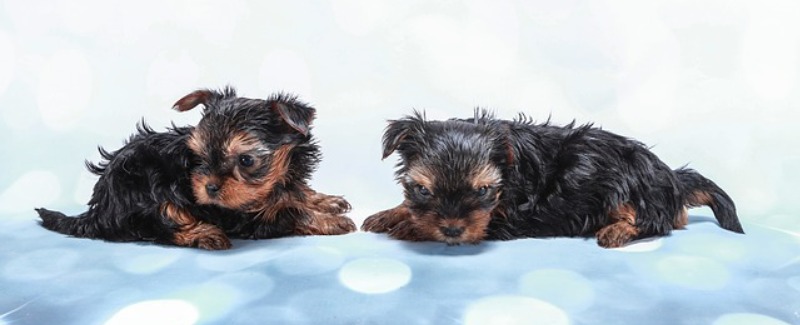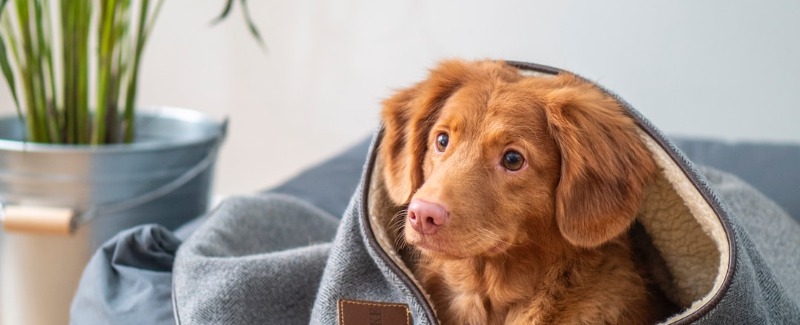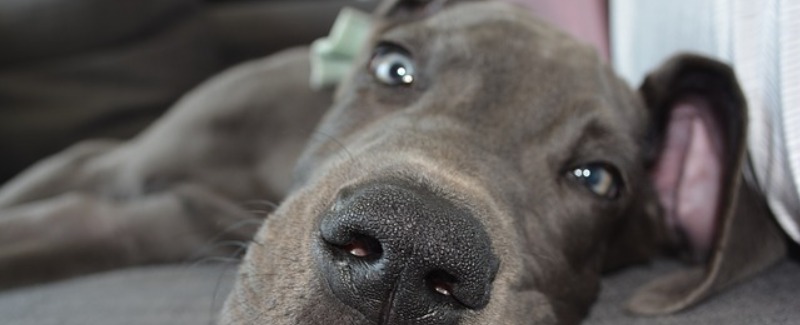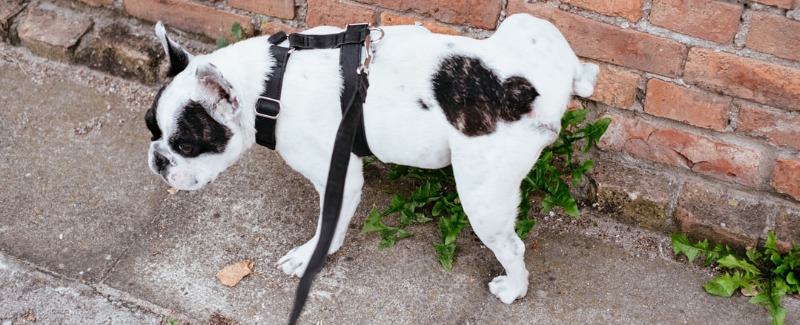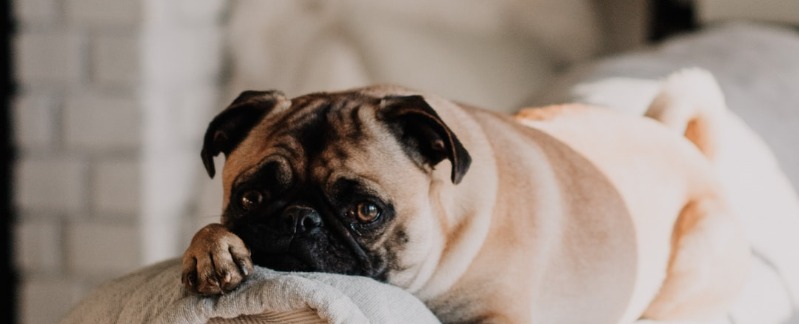Housebreaking problems are the leading cause of abandonment. Owners get frustrated with their pets and make the decision to give up their animals to shelters across the nation. Nothing erodes the bond of man and dog quicker than a puddle or a pile on the carpet. Dogs have a natural housebreaking instinct that involves separating their sleeping place from where they eliminate; we take advantage of this instinct when we housebreak them.
Why Things Go Wrong
Contents
If the natural instinct to eliminate away from the sleeping area is missing, it usually means that the puppy was mishandled and not given the opportunity to eliminate outside of the sleeping area. In some cases, the puppy was not raised by a super clean mom that kept the whelping box free of stool.
In other cases, the puppy may have spent too much time in a cage in a pet store or a shelter and learned to go in her crate because there was no other option. A puppy that doesn’t have this instinct can be a lot more difficult to housebreak.
This doesn’t mean he can’t learn to go in the appropriate place, but it will mean the whole process will take a little longer than average and require you to be more vigilant and flexible with your walking schedule.
Another problem with housebreaking occurs when humans confuse setting limits with being mean or allowing too much freedom too soon. When pups have free run of the house, they go to the bathroom whenever they have to go; as a result, they never learn to hold it. Other pups are not supervised well enough when they have freedom and sneak off to “go” somewhere inappropriate when no one is looking.
Almost all housebreaking problems are caused by human error, which is good news. It means that all you need to do is educate yourself so that you, too, can have a pooch that knows where to eliminate.
Using a Crate to Help Housebreak Your Dog
The dog’s ancestor, the wolf, housebroke himself by sleeping in a cave and eliminating outside that cave. Through the adult’s example, the puppies learned to do the same. We mimic this cave concept when we crate train our dogs.
Crates are not just for housebreaking. They also help keep your puppy safe while you are away and prevent destructive chewing. Though the crate may not be useful to some people as a housebreaking tool, you may find it extremely useful for getting through all of the destructive phases of your dog’s development.
Using a crate is like giving your dog his own bedroom, a place for him to relax and rest without getting into trouble. Being confined to a crate requires that he hold his bladder and bowels to avoid an unpleasant consequence — having to sit in his own mess until you come to rescue him.
Using a crate gives a clear message to a puppy: “Hold it until I let you out.” Such a message takes advantage of his natural instincts to sleep in one place and eliminate in another. Using a crate is the nicest thing you can do for your dog, and if it’s used properly, it will help speed up housebreaking. Following are some tips for using a crate:
- A young puppy (less than sixteen weeks) should be in the crate more than she is out and should only be free when you are there to supervise her.
- No food or water should be given in the crate while you are gone.
- No towels or padding in the crate at first until your dog has been dry in the crate for at least two weeks straight. Otherwise, she may go on the towel and then kick it to the back.
- A puppy between the ages of seven and twelve weeks will need to be taken to the potty spot every hour at first and then every two to three hours after that.
- Hire a pet sitter to provide regular walks if you are gone for long periods during the day.
- Puppies twelve to eighteen weeks can last a bit longer between walks, but you should increase the time gradually.
- If your pup cries or barks in the crate, try to ignore her until she is quiet before letting her out. Covering the crate completely with a sheet or towel often helps puppies settle down to sleep faster, especially if they bark and whine a lot.
- When introducing the crate, leave the door open and entice your puppy in and out with treats or toys. You can also use the clicker and treats to encourage your puppy to go in and out of the crate.
- Put your puppy in the crate frequently when you are home so that she gets used to being away from you for gradually longer periods at a time.
- Keep your crate around throughout the first and second year of your dog’s life. You will find it a godsend if you have workmen doing repairs, company visiting, or if you travel with your dog. If you teach your dog to like her crate, she will always have a safe place to call her own no matter where she goes.
Dogs that can’t use a crate for whatever reason should be supervised constantly and not allowed free access to the rest of the house until they have been reliable with their housebreaking for at least six weeks. Freedom after that should be given gradually until you are certain your dog is reliable.
Charting Your Dog’s Progress
Teaching a dog to use the outside for his bathroom needs is not rocket science, but it can be frustrating and time consuming. You won’t teach your dog to go outside overnight, but there are some tips that will make sure you are moving in that general direction. One really useful tool in house-breaking a dog is a housebreaking chart to keep track of what time he was walked, if he went, and what he did.
A simple chart on the fridge will help the whole family keep track of your puppy’s progress and make it easier to know when your puppy can have some freedom and when he should be supervised carefully for signs that he has to go out. Most puppies will sniff the floor and walk in circles when they need to go out.
Housebreaking Habits
A young pup between seven and 12 weeks should be walked every hour. It is the repetition of being taken to the same spot time and again that gives him the idea of what he needs to do and where to do it. Pick one spot in the yard, keep him on a leash, and only stay out for about one to three minutes.
If he goes, label it something like Hurry Up and play with him, or give him a little freedom in the house or yard. If he doesn’t go, crate him or keep him with you, and try again in 10 or 20 minutes.
If you allow him to roam the yard on his own, chances are he will have so much fun that he will forget to go and end up coming inside and having an accident on the floor. As your puppy gets to be between twelve and eighteen weeks old, you’ll find that he can go longer between potty trips. Use your chart to decide how long that should be.
You can also use your chart to keep track of when your puppy has accidents so that you will know when you need to add in an extra walk or supervise more carefully. Over several weeks of charting, you will be able to put the charts together and determine if you are making progress in the right direction. If you aren’t, you’ll be able to decide what you need to do to get back on track.
No Papers, Please
Using newspapers or potty pads to housetrain your puppy is the surest way to make him unreliable with housebreaking. Dogs that are trained to “go” on newspaper or potty pads never learn to hold it because they go whenever they have to. If you want to housebreak your dog reliably, don’t use paper to train him. Take him outside from day one and don’t look back. If you are currently using newspaper, pick it up and throw it away: Start taking your dog outside today.
Using paper in the house gives your dog the impression that there is a safe place to go inside. When the paper is gone, you will have to walk him more frequently and supervise him more carefully, but he will get the idea over time that the only place he can go is outside.
Some people who have dogs that will weigh less than five pounds as adults choose to teach their dogs to go in a litter box rather than taking them outside. This may be a desirable option for you if you live in a high-rise apartment and it is a long trip to the great outdoors.
Using a litter box works on the same principles of paper training except that the actual potty spot is unique and in no way resembles a carpet or any other surface you are likely to have in your house. It would be ideal to keep this litter box on a balcony or sun porch and walk your dog as though he were going outside to do his business.
If you leave the litter box indoors and allow your dog free access to it, you will have the same problems you would with a paper-trained dog. If your dog can go whenever he wants, he will never learn to hold it and will likely never be truly housebroken.
Using a Leash for Potty Trips
Unless your dog is a rescue dog adopted from a shelter as an adult and absolutely will not go on a leash, it is a good idea to use a leash to take your dog to the potty spot. The leash should be about six feet long. You should stand in one spot; don’t follow the dog all over the yard. Let the dog sniff in a circle around you and praise the heck out of her if she goes. Try not to get her into the habit of walking the neighborhood unless you want to do that in freezing cold weather or pouring rain.
The trick to walking your dog on a leash is to get her to go to the bathroom quickly without too much distraction so that your dog will perform her potty duties quickly and on demand regardless of the weather. The leash acts as a way for you to communicate to your dog that you are not outside to play but to take care of the business at hand.
Label It
Dogs that are taught to go to the bathroom on cue are a pleasure to walk. Even in bad weather, they go out and do their business, and their owners don’t freeze to death waiting for them. Putting the act of eliminating on a cue by calling it something will help speed up the whole ordeal. The common labels for potty behavior are Go, Hurry Up, or Get Busy.
Through training, you can have each function labeled and your dog will go on command whenever you ask. This is really convenient if you’re about to take her inside a store, a friend’s house, or the hospital you’re visiting as a therapy dog team. Since you know your dog has gone and will last until you leave, you can relax and enjoy your visit.
A good rule of thumb for potty trips for unhousebroken dogs is to stay out for one to two minutes, tops. If she goes, praise and give her freedom. If she doesn’t go, either confine her to a crate or gated area or keep her with you for twenty minutes or so and try again later. The message to the dog is “if you go, you get freedom; if you don’t, you don’t.”
To label the potty behavior, say whatever your command is going to be as your dog is in the process of going. You can even click and treat as she is going to give her the idea that doing her business outside is a good thing. It takes a lot of repetitions for the dog to understand that the command means to “go,” so be patient and make sure everyone in the family knows what commands are being used.
Make a Potty Spot in Your Yard
You may also want to consider creating a potty spot in your yard, a designated place where your dog can do his business without interfering with the beauty of the rest of your yard. Creating one area that clearly says “bathroom” to your dog will help you housebreak her, and it will also keep her from using the whole yard as her toilet. That way if you’d like to have barbecues or let your children play in the yard, you won’t have to worry about scooping the whole yard.
To build the potty spot, you’ll want to use materials that offer good drainage and the ability to disinfect. Here are some potty spot recommendations:
- Make a square or rectangular box out of garden timbers cut to the dimensions you wish. Large dogs probably need an 8′ × 8′ area, whereas smaller dogs could probably live with a 4′ × 4′ space.
- Cover the bottom with several bags of sand.
- Cover the sand with a variety of sizes of crushed stone. Some people prefer the tiny size often called “pea stone;” others prefer the 1 inch diameter.
Designated potty spots will allow you to scoop easily and disinfect with a bleach solution regularly. A weed sprayer with a 30:70 solution of bleach and water works well as a disinfectant. Even in tight quarters, this arrangement eliminates excessive odors and unsanitary conditions. A metal rake may also help you to redistribute the stone and sand.
Confinement Works
Young puppies or even adult dogs that are not housebroken should not have free access to the house. If you allow too much freedom too soon, you will create housebreaking problems. Dogs often consider where they eat and sleep their home. The rest of the house is the outside.
That is why a puppy kept in the kitchen will often run to the dining room to piddle or poop if he gets loose. Using a crate to keep your puppy confined when you cannot watch him is an excellent housebreaking tool.
Try not to put any cozy blankets, newspaper, or bedding inside the crate until the dog has proven himself by staying dry in the crate for two weeks straight. For dogs that cannot be crate trained for some reason, confinement by means of baby gates is key. If the dog is walked on a regular basis, he will do his best to keep his gated area clean.
Control the Food and Water
A puppy is like a sieve: What goes in will come out. Pay attention to how much and how often he eats and drinks and regulate what goes in so you can regulate what comes out. Your unhousebroken dog should not have free access to food and water, because he will eat and drink whenever he wants, and you will be less able to predict when he’ll need to go out.
To housebreak a dog, you need to stick to a strict food and water schedule and be sure that he is walked at regular intervals. Puppies that have a regular feeding routine are easy to predict; if you feed and water them on a schedule, they will go out on schedule.
Providing a consequence for unproductive trips to the potty spot is a good idea. The most logical consequence is a lack of freedom. A dog that normally goes at a certain hour, like first thing in the morning or last thing at night, should not be allowed to play freely in the house or yard until he has had a productive trip outside.
The best way to help a puppy develop a reliable housebreaking schedule is to feed roughly at the same time each day and not leave water out all day and night. Put the food down for ten minutes; if he doesn’t finish, pick it up and put it away until the next meal. Feed a young pup seven to 12 weeks old three times a day, and feed an older puppy or adult dog twice a day. Put the water down at regular intervals and pay attention to how much he drinks. Remember: What goes in comes out.
Don’t Punish Your Puppy for Mistakes
An important aspect of housebreaking a dog successfully is to reward success rather than punish mistakes. Mistakes are really your fault for not walking your puppy at the right time. If you’d like to hit yourself over the head with a rolled-up newspaper, feel free! Your puppy will not learn not to go in the house by being scolded or punished.
If you are not sure you know about all the spots where your dog has gone, consider purchasing a black light (available in some dog supply catalogs) to detect the urine stains on the carpet.
What he will learn is to avoid going in front of you and instead go under the dining room table when no one is looking. The end result is that it will be nearly impossible to get him to go on a leash, because he will come to believe that going in front of some-one is wrong.
Deal with mistakes by ignoring the pup for a while. Put him in a crate or gated room, clean up the mess, and make a note of the time of the accident. Keep track of your dog’s mistakes to see if there is any pattern to them and if you should add in extra walks.
Proper Cleanup Procedures for Accidents
When your puppy has an accident on the carpet or floor, it is essential to clean it up as quickly and as thoroughly as possible to eliminate any lingering odors, because any remaining smell will draw the puppy back to that spot. Here are some tips for cleaning up urine on carpet:
- Blot up as much as possible with paper towels.
- Pour an eight-ounce glass of water over the spot to dilute the urine.
- Blot with more paper towels until there is no hint of yellow on the towels.
- Spray carpet cleaner over the spot and scrub with a brush or a sponge.
- Spray the area again and follow the product’s directions for standing time and vacuuming. Repeat as needed.
- Spray with an enzyme inhibitor, which eliminates the odor, following the product directions exactly.
Cleaning up urine or feces on hardwood floors should be done a little differently to prevent permanent damage to the floor.
- Wipe up excess with paper towels.
- Add a capful of Murphy Oil soap to a bucket of water and wash the area thoroughly with a mop or sponge.
- Dry the area thoroughly with a rag or paper towels.
- Spray an enzyme inhibitor on a cloth and wipe down the area one last time.
Cleaning up feces on carpet can be tricky. Be sure to remove as much as possible with paper towels before treating the area to avoid rubbing the excess into the carpet and thereby compounding the problem.
- Remove all solid waste with paper towels.
- Spray with carpet cleaner and rub out as much as possible with a sponge.
- Spray the area again and use a scrub brush to deep clean the fibers of the carpet.
- Spray the area with carpet cleaner again and follow the product’s directions for standing time and vacuuming. Repeat as needed.
- Spray with an enzyme inhibitor to permanently eliminate the odor.
If your dog tends to continue to go back to the same spot over and over, consider rearranging the furniture a bit to block access to that spot. Cleaning any area where an accident occurred is essential to keeping your dog on track with his housebreaking. If you are cleaning up more than a couple of accidents a week, you are probably not walking your puppy outside often enough or are allowing too much freedom too soon. Remember that limiting a puppy’s freedom is half the key to housebreaking and is only temporary until your puppy proves he knows where to “go” and is completely reliable.
Cleaning up accidents efficiently is very important. A dog’s sense of smell is intense. If accidents are not cleaned up thoroughly, it can draw the animal back to that spot time and again. Many great products on the market today help clean up the mess and also neutralize the odor, making it less likely that your dog will be drawn back to the same spot.
Dogs need to go out at least once during a four-hour period if they are confined to a small area such as a crate. If they have more freedom or free access to food and water, they may have to go more frequently. Most house-broken adult dogs need to be walked first thing in the morning, sometime midday, after work, and before bed. A midday visit from a pet sitter can help your adult dog maintain his excellent housebreaking manners.
A lack of housebreaking is a silly reason to give up a dog to the shelter or pound, but living with a dog that uses your house as her bathroom is no picnic either. Housebreaking manners are the most basic of training issues that must be accomplished if a dog is going to live peaceably with humans. The tricks to housebreaking come down to some very basic elements: Confine the dog in some way; put her on a schedule and keep track of her successes and failures; control the food and water bowls; walk her outdoors in short, frequent spurts; and avoid punishing her mistakes. If you follow these guidelines, your dog should make fairly good progress within a month to six weeks.
Occasionally a dog may have a medical problem that interferes with housebreaking. If you were making good progress with housebreaking but your dog suddenly regresses, consider having your veterinarian check a urine and stool sample for signs of infection or parasites. Both of these medical conditions can be easily treated with medication and will often present themselves as a regression in a housebreaking program.
It is not effective to pursue an issue behaviorally if the real problem lies in a medical condition. If, despite your best efforts, you find your dog’s housebreaking problems baffling or you adopted your dog late in her life and she came with a host of serious behavioral problems, you may want to consider the help of a professional dog trainer or behaviorist.

